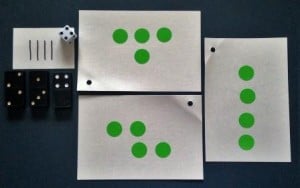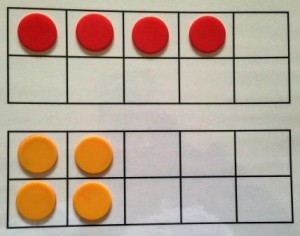by Cindy Elkins, OK Math and Reading Lady
In the next few posts, I will show various ways to conduct daily math meetings which you can incorporate into your daily schedule (as part of your normal morning meeting routine, or at the beginning of your daily math lesson). Daily Math Meetings (10-15 minutes) are vital for quickly reviewing math concepts and number sense in more visual and discussion based format. With primary students, this math meeting might center around the calendar bulletin board (or SMARTboard presentation). With intermediate students, it begins to take on the aspects of a “Number Talk” with a variety of computational strategies being the focus.
PreK – KG Level Components:
- Counting
- Subitizing
- Days of the Week
- Months of the Year
- Graphing (weather, etc.)
- Place Value (tens and ones: ten frames, straws, sticks, etc. to keep track of the days of school – working toward the 100th day)
1st – 2nd Grade Level Components:
- The above plus . . .
- Number Bonds (How can we break apart this number? Such as 10 = 3 + 7 or 6 + 4)
- Place Value and skip counting using a 100 chart
- Number of the Day (word form, base ten form, place on a numberline, tally marks, on a ten frame, expanded form, etc.)
- Ordinal Numbers (using the calendar)
- Counting money (add one cent each day and exchange pennies for nickels, nickels for dimes, etc.)
Subitizing
- 4 is 1 away from 5. 4 is 2 and 2 (or like a square).
See my updated post on this topic by clicking here: https://cindyelkins.edublogs.org/2016/09/03/subitizing-what-does-that-mean/
This is such an important process in the continuum of counting, adding, and subtracting numbers. It means students can recognize certain quantities without physically counting each one. KG should be able to do this for up to 10 objects, and 1st grade up to 20. If you hold up a ten frame with the top row filled up, students should recognize it as 5 immediately. If you hold up 2 completed ten frames or 2 base ten rods, students should recognize this as 20 immediately. Use structured arrangements such as dice, dot cards, dominoes, ten frames, and base ten manipulatives during your math meeting to both assess the skill of subitizing and practice how to “see” the arrangements.
As part of your math meeting, have some of these subitizing materials available. Flash to students for 2 seconds. Observe who is trying to count them 1 by 1 and who immediately recognizes the amount. Randomly ask, “How did you see it?” For example, if you flashed a 5 dice pattern, did they see the 4 dots in a square with 1 in the middle, or as 2, 2, and 1, or just immediately as 5? Explaining their thinking is another important math process. The book, “Number Talks”  is a fantastic resource for this with specific suggestions on which dot cards to use each day to build on the known to help with the new. Click here for a link to this book.
is a fantastic resource for this with specific suggestions on which dot cards to use each day to build on the known to help with the new. Click here for a link to this book.

